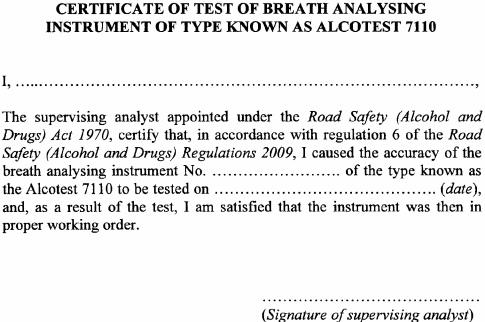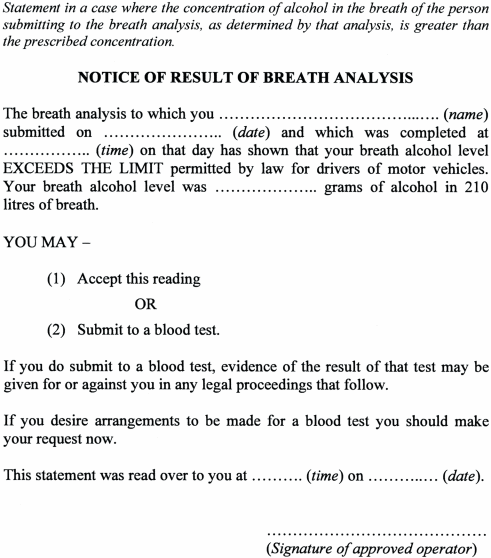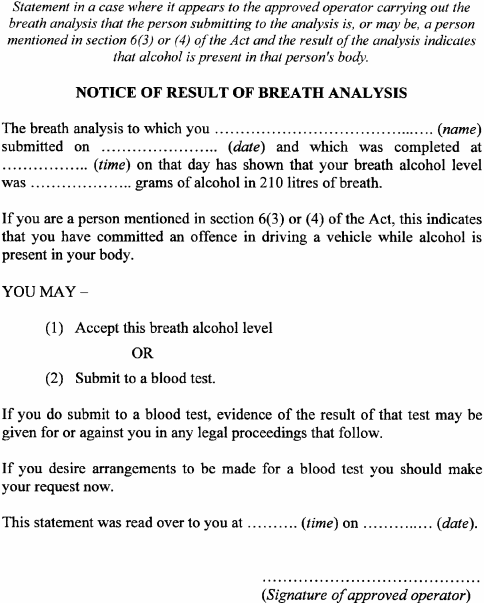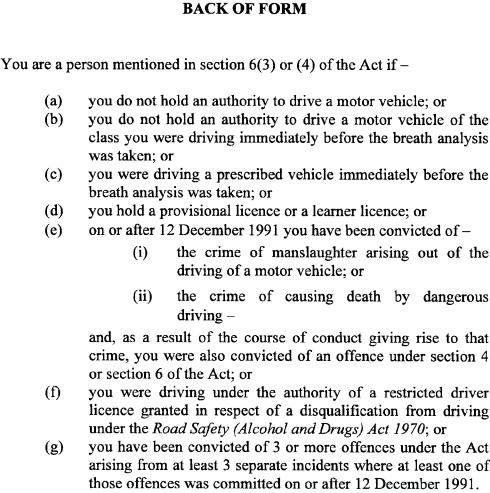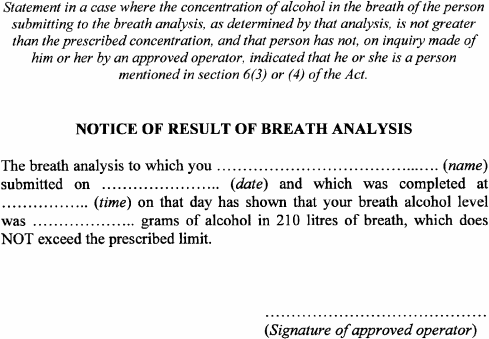Road Safety (Alcohol and Drugs) Regulations 2009
I, the Governor in and over the State of Tasmania and its Dependencies in the Commonwealth of Australia, acting with the advice of the Executive Council, make the following regulations under the Road Safety (Alcohol and Drugs) Act 1970 .
2 November 2009PETER G. UNDERWOOD
Governor
By His Excellency's Command,
J. G. COX
Minister for Police and Emergency Management
PART 1 - Preliminary
These regulations may be cited as the Road Safety (Alcohol and Drugs) Regulations 2009 .
These regulations take effect on the day on which their making is notified in the Gazette.
(1) In these regulations –Alcotest 7110 means the breath analysing instrument known by that name;Principal Act means the Road Safety (Alcohol and Drugs) Act 1970 ;Related Act means the Marine Safety (Misuse of Alcohol) Act 2006 .(2) In these regulations, a reference to a form by number is a reference to the form of that number in Schedule 1 .
PART 2 - Administrative
4. Qualifications of certain approved analysts
The qualifications prescribed for the purposes of section 3(5)(b) of the Principal Act are –(a) a Bachelor of Science or a Bachelor of Pharmacy, or equivalent qualification; and(b) at least 2 years' full-time postgraduate experience in chemistry, pharmacy or toxicology.
5. Duties of supervising analyst in relation to Alcotest 7110
The supervising analyst in relation to an Alcotest 7110 is to ensure that –(a) it is properly maintained; and(b) approved operators are, from time to time, given such written instructions in relation to the use of that instrument as the supervising analyst considers necessary and appropriate.
6. Testing and use of Alcotest 7110
(1) The supervising analyst is to cause the accuracy of an Alcotest 7110 to be tested from time to time.(2) Where an Alcotest 7110 is tested in accordance with subregulation (1) and the supervising analyst is satisfied that it is accurate, he or she is to issue and sign a certificate in accordance with Form 1, stating the date on which the instrument was so tested.(3) An approved operator is not to use an Alcotest 7110 for carrying out breath analysis for the purposes of the Principal Act or the Related Act unless a certificate referred to in subregulation (2) has been issued in respect of that instrument stating that the instrument was tested on a date not earlier than 6 months before the date on which the instrument was so used.
7. Duties of approved operators in relation to Alcotest 7110
(1) In this regulation –relevant enactment means –(a) for a breath analysis carried out under and for the Principal Act, section 11 of the Principal Act; and(b) for a breath analysis carried out under and for the Related Act, section 29 of the Related Act.(2) While an Alcotest 7110 is being used by an approved operator for carrying out a breath analysis, the operator is to ensure –(a) that the person submitting to the breath analysis gives a sample of breath into a mouthpiece supplied by the operator; and(b) that an unused mouthpiece is provided for use in the breath analysis; and(c) that the operator does not carry out a breath analysis unless he or she is satisfied that the person has not consumed intoxicating liquor during the 15 minutes preceding the analysis; and(d) after the completion of the breath analysis –(i) that the operator records the resultant reading of the breath analysis; and(ii) that the operator inquires of the person whether the person is –(A) for a breath analysis carried out under and for the Principal Act, a person mentioned in section 6(3) of the Principal Act; or(B) for a breath analysis carried out under and for the Related Act, an operator of a commercial vessel; and(iii) that the operator completes and signs the written statement required by the relevant enactment; and(e) that the person submitting to the breath analysis is provided with a copy of the Alcotest 7110 printout supplied by that instrument.
8. Approved operators to carry out instructions
An approved operator is to carry out any instructions given to him or her by the supervising analyst under regulation 5(b) .
9. Record to be maintained by approved operators
(1) In this regulation –record, in the case of an Alcotest 7110, includes a printout supplied by that instrument.(2) An approved operator is to maintain, in such form as the supervising analyst requires, a record containing such particulars as the supervising analyst requires in respect of the exercise by that operator of his or her functions under the Principal Act and the Related Act, or under either of those Acts.
PART 3 - Blood Samples
(1) In this regulation –relevant enactment means –(a) for a blood sample taken under and for the Principal Act, section 13(4) of the Principal Act; and(b) for a blood sample taken under and for the Related Act, section 32(2) of the Related Act.(2) For the purposes of the relevant enactment, a sample of blood is to be taken in a manner, or carried out in a manner, that conforms with the following requirements:(a) the sample is to consist of approximately 15 millilitres of blood;(b) no alcohol, ether, acetone or any other volatile organic substance is to be used as, or contained in, the skin disinfectant used at the site from which the sample is taken;(c) the instruments used for the purpose of taking the sample are to be sterilised in a manner that does not leave any residue of a volatile organic substance on those instruments;(d) after placing a part of the sample in a suitable container, the cap is to be replaced and the container inverted about 30 times to dissolve the substances contained in the container in the blood and thoroughly mix the solution.(3) An instrument packed in a form in which it is intended to be supplied for use in medical practice is taken to have been sterilised in accordance with subregulation (2)(c) .
11. Labelling of blood samples
(1) In this regulation –control sample means that part of a blood sample that may not, except as a court may otherwise direct, be analysed or otherwise dealt with except on a request under –(a) in the case of a sample taken under and for the Principal Act, section 13B(1) of the Principal Act; and(b) in the case of sample taken under and for the Related Act, section 35(3) of the Related Act;relevant enactment means –(a) for a blood sample taken under and for the Principal Act, section 13(5A) of the Principal Act; and(b) for a blood sample taken under and for the Related Act, section 32(5) of the Related Act.(2) For the purposes of the relevant enactment, each container into which a part of the sample of blood is placed is to be labelled in the following manner:(a) the label on each container is to be marked with the name of the person from whom the sample was taken, the date and time at which it was taken and the name of the medical practitioner or qualified nurse by whom it was taken;(b) the label on the container containing the control sample, in addition to being marked as prescribed by paragraph (a) , is to be marked with the word "Control".
12. Provisions relating to blood samples delivered to police officers
(1) In this regulation –delivered means –(a) in the case of a blood sample taken under and for the Principal Act, delivered pursuant to section 13(5B) of that Act; and(b) in the case of a blood sample taken under and for the Related Act, delivered pursuant to section 32(6) of that Act;police station includes, in the case of the Related Act, a police vessel or a shore facility used in connection with the operation of police vessels;relevant enactment means –(a) for a blood sample taken under and for the Principal Act, section 13A(1) of the Principal Act; and(b) for a blood sample taken under and for the Related Act, section 34(2) of the Related Act.(2) For the purposes of the relevant enactment, a container containing part of a sample of blood that is delivered to a police officer is to be kept –(a) in the police officer's possession, if he or she does not detain the person from whom the sample is taken after the officer has charged the person with an offence under the Act; or(b) at a police station in a place of safety, if that person is detained after being so charged.(3) The officer in charge of the police station at which a person is charged with an offence under the Act and at which that person's sample of blood has been taken is prescribed as the person to whom a request referred to in section 13A(3) of the Principal Act or, as the case may be, section 34(4) of the Related Act is to be made.
PART 4 - Miscellaneous
13. Police officer to receive copy of report of analysis
The police officer who requested that the sample be taken is the prescribed police officer for the purposes of section 13B(2)(c) of the Principal Act and section 35(6)(b)(ii) of the Related Act.
For the purposes of section 10(8) of the Principal Act, the prescribed means of identification is a tag, or a label or other similar article, bearing the word "DRIVER".
For the purposes of section 11 of the Principal Act, the prescribed form of written statement is –(a) Form 2, in the case where the concentration of alcohol in the breath of a person submitting to a breath analysis, as determined by that analysis, is greater than the prescribed concentration; and(b) Form 3, in the case where –(i) it appears to an approved operator carrying out a breath analysis that the person submitting to the analysis is, or may be, a person mentioned in section 6(3) or (4) of the Principal Act; and(ii) the result of that analysis indicates that alcohol is present in that person's body; and(c) Form 4, in the case where –(i) the concentration of alcohol in the breath of a person submitting to a breath analysis, as determined by that analysis, is not greater than the prescribed concentration; and(ii) that person has not, on inquiry made of him or her by an approved operator, indicated that he or she is a person mentioned in section 6(3) or (4) of the Principal Act.
For the purposes of the Principal Act, the following drugs are prescribed as illicit drugs:(a) 3,4-methylenedioxyamphetamine (MDA);(b) 3,4-methylenedioxyethylamphetamine (MDEA);(c) 3,4-methylenedioxymethylamphetamine (MDMA, ecstasy);(d) amphetamine;(e) cocaine;(f) delta-9-tetrahydrocannabinol (THC);(g) diacetylmorphine (heroin);(h) gamma-hydroxybutyric acid (GHB);(i) ketamine;(j) lysergic acid diethylamide (LSD);(k) methaqualone (Quaalude);(l) methylamphetamine (speed);(m) morphine;(n) N,N-diethyltryptamines (DET);(o) N,N-dimethyltryptamines (DMT);(p) paramethoxyamphetamine (PMA);(q) phencyclidine (PCP);(r) psilocybin (magic mushrooms).
17. Liability for costs of medical report and examination
For the purposes of section 19(5) of the Principal Act, the sum of $20 is prescribed as the sum exceeding which a person becomes liable to pay for the whole or a portion of the costs of a medical report and examination under that section.
The legislation specified in Schedule 2 is rescinded.
SCHEDULE 1 - Forms
Regulations 3 , 6 and 15
Form 1
Form 2
Form 3
Form 4
SCHEDULE 2 - Legislation rescinded
Road Safety (Alcohol and Drugs) Regulations 1999 (No. 173 of 1999) |
Displayed and numbered in accordance with the Rules Publication Act 1953.
Notified in the Gazette on 11 November 2009
These regulations are administered in the Department of Police and Emergency Management.
EXPLANATORY NOTE
(This note is not part of the regulation)
These regulations, which replace the Road Safety (Alcohol and Drugs) Regulations 1999 , prescribe a range of matters for the purposes of the Road Safety (Alcohol and Drugs) Act 1970 (and, by extension, the Marine Safety (Misuse of Alcohol) Act 2006 ), including –(a) the maintenance, testing and use of the breath analysing instrument known as the Alcotest 7110; and(b) the taking, labelling and keeping of blood samples; and(c) forms; and(d) the prescribing of illicit drugs.


